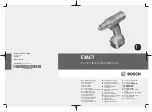
Page 49
EA Elektro-Automatik GmbH
Helmholtzstr. 31-37 • 41747 Viersen
Germany
Fon: +49 2162 / 3785-0
Fax: +49 2162 / 16230
www.elektroautomatik.de
EL 9000 B 15U/24U Series
3.5
Remote control
3.5.1
General
In this cabinet device, remote control is only considered for the master unit. Slave unit can only be monitored, by
any available interface. Remotely controlling the master is possible via its built-in analog or USB port or via one of
the optional interface modules (IF-AB series).
Important here is that only the analog or one digital interface can be in control. It means that if, for example, an
attempt were to be made to switch to remote control via the digital interface whilst analog remote control is ac-
tive (pin REMOTE = LOW) the device would report an error via the digital interface. In the opposite direction, a
switch-over via pin REMOTE would be ignored. In both cases, however, status monitoring and reading of values
are always possible.
3.5.2
Control locations
Control locations are those from where the device can be controlled. Essentially there are two: at the device (manual
operation) and external (remote control). The following locations are defined:
Displayed location Description
-
If neither of the other locations is displayed then manual control is active and access from
the analog and digital interfaces is allowed. This control location isn’t explicitly displayed
Remote:
Remote control via any interface is active
Local
Remote control is locked, only manual operation is allowed
Remote control may be allowed or inhibited using the setting
Allow remote control
). In inhibited
condition the status
Local
will be displayed top right. Activating the inhibit can be useful if
the device is remotely controlled by software or some electronic device, but it’s required to make adjustments at
the device or deal with emergency, which would not be possible remotely.
Activating condition
Local
causes the following:
•
If remote control via the digital interface is active (
Remote:
), then it’s immediately terminated and in order to
continue remote control once
Local
is no longer active, it has to be reactivated at the PC
•
If remote control via the analog interface is active (
Remote: Analog
), then it’s temporarily interrupted until remote
control is allowed again by deactivating
Local
, because pin REMOTE continues to signal “remote control = on”,
unless this has been changed during the
Local
period.
3.5.3
Remote control via a digital interface
3.5.3.1
Selecting an interface
All models of this series support the following optionally available interface modules in the interface slot on the
master unit:
Short ID
Type
Ports
Description*
IF-AB-CANO
CANopen
1
CANopen slave with generic EDS
IF-AB-RS232
RS232
1
Standard RS232, serial
IF-AB-PBUS
Profibus
1
Profibus DP-V1 slave
IF-AB-ETH1P
Ethernet
1
Ethernet TCP
IF-AB-PNET1P
ProfiNet
1
Profinet/IO slave
IF-AB-MBUS
ModBus TCP
1
ModBus TCP
IF-AB-ETH2P
Ethernet
2
Ethernet TCP, with switch
IF-AB-MBUS2P
ModBus TCP
2
ModBus TCP, with switch
IF-AB-PNET2P
ProfiNet
2
Profinet/IO slave, with switch
IF-AB-CAN
CAN
1
CAN 2.0 A / 2.0 B
IF-AB-ECT
EtherCAT
2
Basic EtherCAT slave with CoE
* For technical details of the various modules see the extra documentation “Programming Guide Modbus & SCPI”
















































